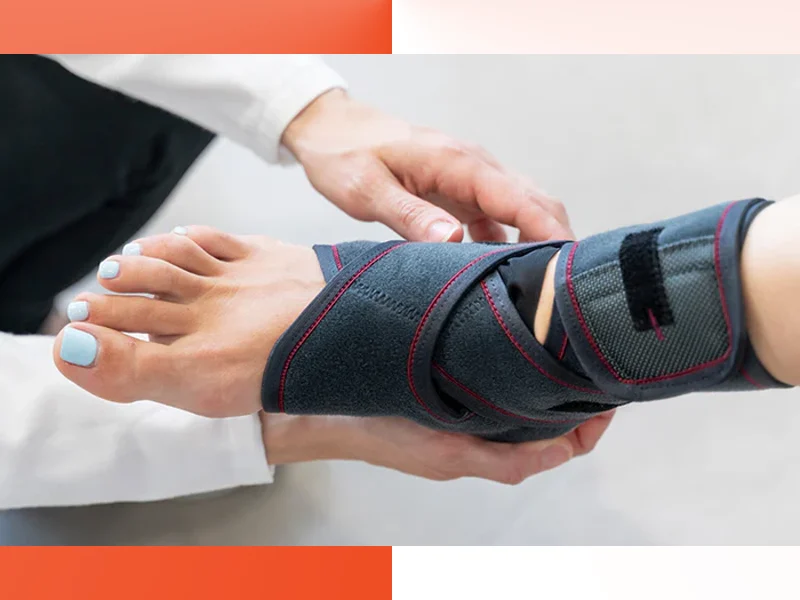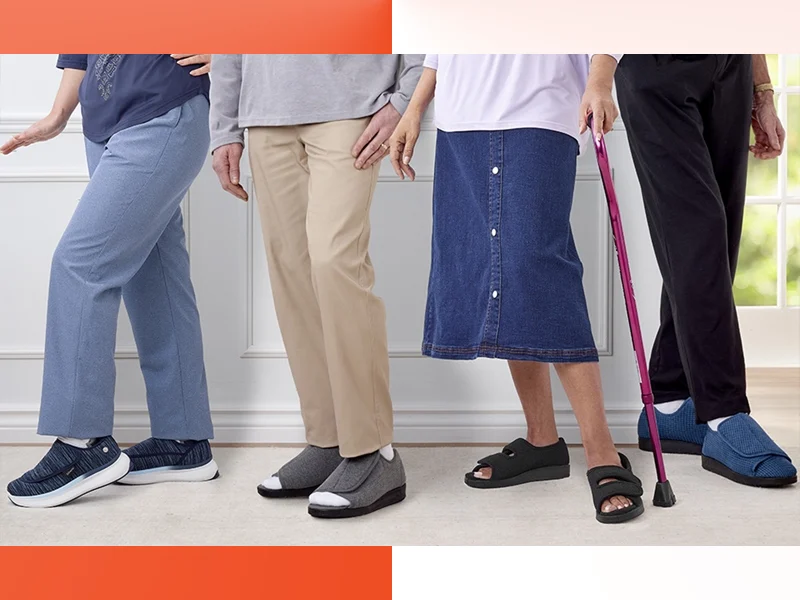Maintaining mobility and staying active are essential for a healthy and fulfilling lifestyle as we age. Regular activity helps ensure physical health, supports mental well-being and promotes independence. However, the natural aging process often introduces various challenges hindering these goals. Decreased joint stability, increased risk of falls, and the fear of getting injured can significantly impede the ability to stay active and move freely. Ankle braces offer a practical and supportive solution for seniors navigating these challenges effectively. Ankle braces provide stability and support to one of the body’s most vulnerable joints. They play a crucial role in preventive care and recovery processes, helping manage and mitigate the risks associated with weakened joints and unsteady balance. Stabilizing the ankle and reducing its load during activities, these braces help seniors maintain an active lifestyle without the constant fear of injury.
This blog delves deep into ankle braces, exploring their numerous benefits for seniors, practical advice on how they can be used effectively, and essential tips for integrating them into everyday life to enhance mobility and independence. Whether you’re a senior experiencing mobility issues, a caregiver, or simply planning to maintain your mobility, understanding how to leverage ankle braces can significantly improve your quality of life and ability to stay active and engaged in your later years.
Understanding Ankle Braces
Ankle braces are specialized supportive garments carefully crafted to wrap around the ankle, offering enhanced stability and robust support. They serve a multifaceted purpose: safeguarding against potential injuries, managing pre-existing ankle conditions, and bolstering confidence during physical activities. These devices are particularly invaluable for seniors who may experience diminished joint stability as part of aging.
Key Features of Ankle Braces
- Support: Ankle braces provide crucial support to the ankle joint, which may be weakened due to age-related wear and tear or previous injuries. This support helps to align the foot correctly with the leg, reducing undue stress on the ankle.
- Stability: By enhancing stability, ankle braces help to prevent abnormal movements of the ankle, such as excessive twisting and turning, that can lead to sprains or more severe injuries.
- Compression: Many ankle braces offer compression, which can help to reduce swelling and improve blood circulation around the ankle and lower foot area. This feature is especially beneficial following an injury or during recovery from surgery.
Types of Ankle Braces
- Soft Ankle Braces: Made from stretchable materials like neoprene or knit fabric, soft braces offer flexibility and comfort, making them ideal for everyday use in preventing common ankle injuries.
- Semi-Rigid Ankle Braces: These braces combine flexibility with firmer support, often incorporating elements like plastic or metal stays to provide additional stability without being overly restrictive.
- Rigid Ankle Braces: Offering the highest level of support and stability, rigid ankle braces are typically used post-injury or post-surgery to immobilize the ankle during the healing process. They are crucial when movement could delay recovery or exacerbate an injury.
Choosing the Right Ankle Brace
Selecting the appropriate ankle brace depends on several factors, including the level of support needed, planned activities, and any existing ankle issues. Choosing a brace that balances support with comfort and ease of use is essential for seniors. Factors such as how easy it is to wear and remove the brace and its ability to fit comfortably under footwear are crucial considerations.
Custom vs. Off-the-Shelf Ankle Braces
- Custom Ankle Braces: These are tailored to fit the exact contours of your ankle, providing specific support based on individual needs. They are usually recommended by healthcare professionals for patients with unique anatomical needs or severe instability.
- Off-the-Shelf Ankle Braces: These are mass-produced and available in various sizes. While they offer a general level of support suitable for most people, they may not address specific biomechanical issues as effectively as custom-made braces.
Understanding the different types of ankle braces and their features can significantly aid in making an informed decision about which brace is best suited to enhance mobility and stability, particularly for seniors seeking to maintain an active lifestyle while managing the physical challenges of aging.
Why Ankle Braces Are Essential for Seniors?
As individuals age, their bodies undergo various changes that can impact mobility and increase the risk of injuries. Ankle braces serve as a critical tool for seniors, offering support and protection that help address these age-related challenges. Here’s a closer look at why ankle braces are particularly beneficial for the elderly:
Enhanced Stability
- Support for Weakened Joints: Ankle braces provide necessary support to weakened joints and muscles, which may have deteriorated due to age or disuse. This support helps maintain proper alignment and balance, which is crucial for preventing falls.
- Risk Reduction: By securing the ankle in a stable position, these braces significantly reduce the risk of sprains or falls—a common concern for seniors who may have balance issues or a slower reaction time to sudden shifts in movement.
Injury Prevention
- Protection During Activity: Ankle braces act as a protective barrier by supporting the ankle during various activities, from daily walking to more strenuous exercise. This support is vital for preventing the recurrence of old injuries and the risk of new ones.
- Continuous Support: Regular use of ankle braces, especially during activities that put stress on the joints, helps maintain an active lifestyle without the setbacks of repeated injuries.
Pain Relief
- Reduction of Strain: Ankle braces help distribute weight more evenly and reduce the load on the ankle joint, which can alleviate pain caused by overuse or arthritis.
- Inflammation Management: For conditions like arthritis or tendonitis, the compression of some ankle braces can decrease swelling and inflammation, providing much-needed relief during physical activities.
Improved Confidence
- Boost in Mobility: With ankle braces’ enhanced stability and pain relief, seniors can feel more confident in their ability to move and perform daily tasks. This confidence can be transformative, leading to a more active and fulfilling lifestyle.
- Encouragement of Independence: An ankle brace’s security and support can encourage seniors to maintain their independence by allowing them to participate in household chores, recreational activities, and social engagements without fear of injury.
Promoting Long-Term Health
- Longevity of Mobility: Ankle braces contribute to seniors’ long-term health and mobility by enabling more regular activity. Staying active helps improve cardiovascular health, strengthens muscles, and boosts mental health.
- Quality of Life: Regular physical activity supported by ankle braces enhances physical health and improves overall quality of life by fostering greater independence and social interactions.
Ankle braces are an indispensable aid for seniors, providing the stability, protection, and confidence needed to navigate the challenges of aging. With the right ankle brace, seniors can enjoy an active, independent, and fulfilling lifestyle while minimizing the risk of injury and discomfort.
How to Use Ankle Braces Effectively?

Ankle braces can be an excellent aid for seniors seeking to maintain or improve mobility. However, to get the most out of their use, it’s essential to understand the best practices for their application and maintenance. Here are some detailed tips to help ensure that ankle braces serve their intended purpose effectively and safely:
Consult Healthcare Professionals
- Personalized Assessment: Before using an ankle brace, consult a healthcare provider such as a doctor or physiotherapist. These professionals can assess your specific needs based on your medical history, existing conditions, and overall mobility goals.
- Custom Recommendations: A healthcare professional can also recommend the type of ankle brace that would be most effective for your particular condition, whether for general support, injury recovery, or to aid chronic conditions like arthritis. They can guide you on correctly wearing the brace for maximum benefit.
Wear During Activities
- Appropriate Usage: Ankle braces should be worn during activities that might stress the ankle joints. This includes exercise routines such as walking or light jogging and potentially strenuous daily activities like gardening, shopping, or cleaning.
- Preventative Support: Even if you’re not experiencing current ankle issues, wearing an ankle brace during higher-risk activities can protect against potential injuries or worsening an existing condition.
Regular Inspection
- Maintenance Checks: Regularly inspect your ankle brace for signs of wear and tear. Look for stretching, fraying, or any breakage in the material. Also, check if any fasteners or straps are in good working condition to ensure the brace can still provide the proper support.
- Hygiene: Since ankle braces are worn directly against the skin for prolonged periods, keeping them clean is essential. Follow the manufacturer’s instructions for cleaning to prevent skin irritation or infections.
Proper Fit and Adjustment
- Ensuring a Good Fit: Make sure your ankle brace fits well. A brace that’s too tight may restrict circulation, while one that’s too loose won’t provide adequate support. Adjust the straps or closures to achieve a snug yet comfortable fit.
- Adaptations Over Time: As you use the brace, it may stretch, or your ankle might change in size due to various factors like weight loss or increased swelling. Regularly adjust the fit to accommodate these changes, ensuring the brace remains effective.
Educate Yourself on Usage
- Learn Proper Techniques: Educate yourself on how to put on and take off the ankle brace correctly. Incorrect application can diminish the brace’s effectiveness and may even lead to further injury.
- Follow Duration Guidelines: As your healthcare provider recommends, pay attention to how long and often you should wear the ankle brace. Overusing an ankle brace can sometimes lead to dependency or decreased muscle strength.
By following these comprehensive guidelines, seniors can effectively utilize ankle braces to enhance mobility and maintain an active lifestyle. Ankle braces are supportive devices and empowerment tools that enable seniors to confidently engage in daily activities and exercise routines, contributing to overall health and independence.
Read More: Understanding Ankle Braces: Uses, Benefits, and Types
Integrating Ankle Braces into Daily Life
Introducing ankle braces into your routine and making them a part of your daily life can significantly impact your mobility and overall health. Here’s how you can make the most of using ankle braces:
Gradual Introduction
- Acclimatization: Start by wearing the ankle brace for short periods, such as a few hours each day, to allow your body to adjust to the new level of support. Gradually increase the duration as you become more comfortable with the brace.
- Initial Discomfort: It’s normal to experience discomfort when wearing a new brace. However, this should diminish as your ankle gets accustomed to the added support. If discomfort persists, consult a healthcare professional to ensure proper fit and usage.
Combine with Other Supports
- Holistic Approach: Sometimes, an ankle brace alone may not be enough to provide the comprehensive support you need. Pairing your ankle brace with other supportive devices like walking sticks, canes, or orthotic shoes can create a more stable and supportive environment for movement.
- Customized Solutions: Each person’s needs are different. Work with a healthcare provider to find a combination of supports that effectively addresses your specific mobility challenges.
Follow a Balanced Exercise Regimen
- Strengthening and Flexibility: Regular exercises that focus on strengthening the muscles around the ankle and improving flexibility can enhance the effectiveness of your ankle brace. Activities like yoga, Pilates, and light resistance training are excellent for building strength and improving balance.
- Professional Guidance: Consider consulting with a physical therapist who can design an exercise program tailored to your needs. This program can help you safely build strength and flexibility without overtaxing your joints.
Lifestyle Tips for Seniors Using Ankle Braces

Stay Active
- Regular Movement: Consistent, gentle exercise is crucial in maintaining joint function and muscle strength. It keeps the joints lubricated, and muscles engaged, reducing the risk of stiffness and injury.
- Variety in Activities: Incorporate a mix of cardiovascular, strength, flexibility, and balance exercises to keep your routines engaging and comprehensive.
Monitor Your Walk
- Safe Environments: Be mindful of the surfaces you walk on. Uneven or slippery surfaces can increase the risk of falls. Indoors, remove any trip hazards such as loose rugs or clutter.
- Appropriate Footwear: Wear shoes that provide good support and have non-slip soles. Proper footwear can significantly enhance the effectiveness of your ankle brace and reduce your risk of falling.
Social Activities
- Community Engagement: Participating in group activities or joining exercise classes designed for seniors can keep you physically active, mentally stimulated, and socially connected.
- Social Networks: Building a network of friends or acquaintances in similar situations can provide emotional support and motivation, making physical activities more enjoyable and sustainable.
Conclusion
Ankle braces are more than support mechanisms; they enhance the quality of life for seniors striving to remain active and independent. By providing the necessary support and stability, ankle braces allow seniors to continue engaging in the activities they enjoy, promoting a healthy, active, and fulfilling lifestyle as they age. With the right approach, careful integration into daily life, and support from healthcare professionals, ankle braces can be instrumental in helping seniors thrive during their golden years.




